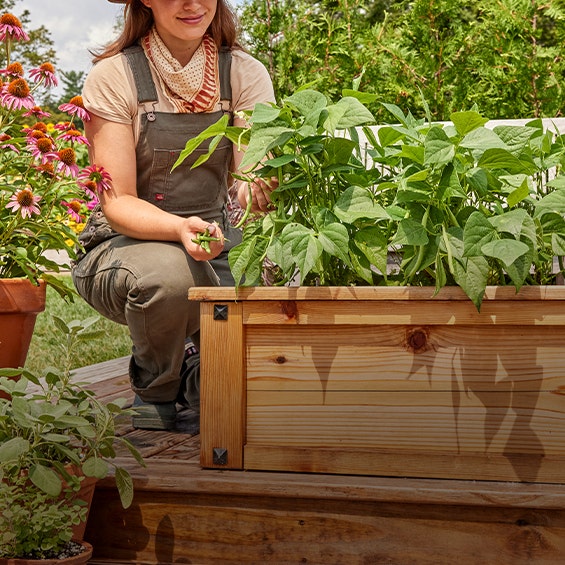


You've heard the terms tossed around, but maybe you've never quite understood: What is the difference between annuals and perennials? It's a simple but important distinction that describes how long your plants live. Let's break down the lingo so you can shop and care for your plants with confidence.
What Are Annuals?
Annuals are plants that complete their life cycles in a single growing season. Annuals start as seeds, then germinate and produce stems, leaves, flowers and seeds or fruit. Then they die, usually with the first frost (although many gardeners frantically cover their plants on chilly fall nights to extend the season just a little longer).
Chances are, many of your favorite flowers, fruits and veggies are annuals. Common examples include:
Flowers
Calibrachoa
Coleus
Geraniums
Gomphrena
Impatiens
Marigolds
Pansies
Petunias
Vincas
Violas
Produce
Beans
Broccoli
Carrots
Corn
Cucumbers
Eggplants
Peppers
Peas
Pumpkins
Tomatoes
Hardy annuals drop seeds that survive the winter, which germinate and pop up the following spring as brand-new plants. Their self-seeding cycle essentially gives them the same staying power as perennials. A few hardy annuals include borage, California poppies and snapdragons.
What Are Perennials?
Perennials are plants that live for more than two growing seasons. While their leaves and stems may wither over the winter, their roots lie dormant underground. They begin a new growth cycle each spring.
Perennials' lifespans vary widely. For example, some, such as columbine, may only live a handful of years, while others, such as peonies, can persist for decades.
Your growing zone also impacts what makes a perennial where you live. For example, you can grow angelonia as a perennial in zones 8 to 10, but it will freeze and die further north, where it works best as an annual. Consult your potential plant's tag, seed packet or FAQ section for details.
You likely walk by perennials every day. Common examples include:
Trees, both deciduous and evergreen
Shrubs
Butterfly bushes
Hydrangeas
Lilacs
Peonies
Roses
Viburnums
Weigelas
Vegetables and fruit
Asparagus
Blueberries, raspberries and other berries
Rhubarb
Strawberries
Garlic (usually grown as an annual)
Kale (traditionally grown as an annual)
Flowers
Baby's breath
Bulbs, such as crocus, daffodils, hyacinths and tulips
Clematis
Coreopsis
Echinacea
Daisies
Daylilies
Hostas
Phlox
Verbenas
Biennials complete their life cycles in two growing seasons. During the first season, plants produce stems and leaves. In their second season, they grow flowers, fruit and seeds, then die. Common biennials include black-eyed Susans, foxglove and hollyhock.
What Is the Difference Between Annuals and Perennials?
The difference between annuals and perennials is their life cycle length. Annuals complete a single growth cycle, while perennials live for more than two seasons.
Let's explore some other key similarities and differences between annuals and perennials.
Landscape Use
Annuals and perennials both add color, texture and intrigue to any planting bed. However, annual flowers tend to work best in containers, in the front of a border or anywhere your landscape needs quick color. Meanwhile, perennials tend to be more permanent fixtures that lend structure, height and depth to the landscape, and they often look more cohesive in the back or middle of a bed.
Bloom Time
Both the duration and timing of blooms vary widely from plant to plant. But generally speaking, annuals bloom for longer throughout their growing season. For example, marigolds provide a reliable pop of orange from the time you purchase plants until the first frost.
On the other hand, perennials tend to bloom for a shorter time each year but often with bigger blooms and a bolder display. For example, lilacs flower profusely in the spring, then stop for the season.
When to Plant
You can plant store-bought annuals any time during the growing season. However, you should note your plants' flowering timeframe to get the most bloom for your buck. For example, plant cool weather pansies in the spring, then replace them with sun-loving zinnias as summer heats up. Start seeds indoors or direct sow as indicated on your seed packet.
Perennials, on the other hand, perform best when planted in the spring or the fall. Cooler temps and more rainfall make it easier for them to establish roots without combating extreme temps and a lack of H2O.
Cost
Annuals tend to cost less upfront (especially if you grow your own seeds) but last a shorter amount of time. Perennials tend to be a more significant investment but live longer, are often larger and, in many cases, can be divided to create more plants.
Care
During the growing season, annuals and perennials both thrive with basic gardening best practices, such as:
Providing quality soil or using potting mix for any containers
Planting them where they'll receive proper sunlight
Watering adequately
Feeding or fertilizing as recommended
Removing spent flowers, also known as deadheading
Pruning back dead or unhealthy branches and stems
At the end of the season, the process differs slightly. Promptly remove annuals and cut back herbaceous perennials (ones that die back entirely) so they don't harbor pathogens, pests or bacteria over the winter. Leave woody shrubs intact, but note they may need a late-winter pruning depending on the type.
How to Choose Between Annuals and Perennials
When selecting what to plant, consider what your landscape is lacking, how much space you have to fill, your budget and how often you're willing to replant. Each type of plant has pros and cons, but both play an important role in a well-composed landscape. Think of perennials as the backbone of your garden — tried-and-true base layers around which you can sprinkle in annuals where you need color, texture or just want to mix things up.
Most healthy, beautiful and thriving gardens feature a mix of annuals and perennials. Now that you know the difference between annuals and perennials, you can confidently plan a well-balanced garden you'll love to look at all season long.
New to gardening? Get 5 must-know tips for beginners.



